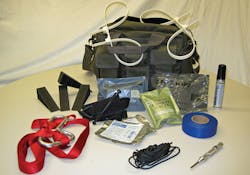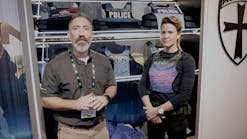The Basic Police Go-Bag
Let’s face it: active shooter incidents aren’t going away and we’re seeing them more often in locations that AREN’T schools. So the need for a patrol rifle accompanied by your Go-Bag, sitting in your trunk, maintained and ready to go, still exists. Therefore I ask you… what’s in your Go-Bag? While that seems a simple question to answer (if you’re honest), perhaps we need to consider what kind of bag it should be and what it makes sense to have in it.
Before I get too far into that, let me point out what, to me, is an essential difference between the law enforcement crisis incident response go-bag and the all-too-commonly-discussed bugout bag: An LE go-bag is loaded to equip the officer with essentials to support him (or her)self through the response and fight against one or more active shooters. A bugout bag is more of a general purpose 72-hour (or more) survival pack. All I’m discussing in this article is the LE go-bag.
First and foremost I think we need to realize that although a backpack is better to have than nothing, it’s not the most convenient or efficient type of bag to use for this purpose. After all, some of the items in your go-bag need to be accessed on the move, and that’s difficult to do if everything is in a pack on your back. To my way of thinking, a go-VEST is even better than a go-bag, but the difference is really equipment placement and your choice.
For the purpose we’re discussing, a go-bag that is shoulder-slung and worn cross-body is probably best. It should hang on your weak-side, probably just behind your hip but easily accessible on the move. The bag also needs to be big enough to hold your necessities for the scenario but not so big that you feel pressured to fill it with everything under the sun, making it 1) too heavy to function comfortably with, and 2) so full of crap that you can’t find what you need in a hurry. Given those restrictions, however, you need to realize that is different for every officer. What I can comfortably carry is far different from what my 6’4” 290 pound patrol partner can carry. That recognized, we still have to have the same basics.
Those basics are:
- Extra ammo for your long gun
- Extra ammo for your handgun
- Flexi-cuffs or extra handcuffs
- Flashlight
- Personal IFAK (Individual First-Aid Kit)
- Tourniquet
- (2) pressure bandages
- Quik-Clot gauze (or similar)
- (6) door stops (to hold doors open or closed)
- Spring-loaded window punch
- All surface black magic marker
There are certainly other items you can include and other authors/instructors will add to that list with items they feel are mandatory. What I’ve listed is MY mandatory list.
Extra ammo for your long gun: This seems like a no-brainer. You have no idea how much you’ll need and “too much” only means you can’t carry it or maneuver with it. For my AR-15 I have four 30-round magazines. With one in the gun, that leaves me three to carry in the go-bag. I think of that as a happy minimum.
Extra ammo for your handgun: because you simply cannot allow yourself to run out of ammo. If your long gun experiences a stoppage you can’t rapidly clear, and/or you run out of ammo for it, you can’t call “time out” and go get more or a different gun. You have to keep going with what you have. If that means your handgun then you’d better have enough ammo to stay in the fight/hunt. On most police gun belts there are two extra pistol magazines and most of today’s duty handguns carry 10-15 rounds of ammo per magazine. I recommend three more pistol magazines in your go-bag. If it’s possible to place them in relatively the same position as they are on your belt for ease of grabbing for reloads under pressure, that’s highly desirable.
Flexi-cuffs or extra handcuffs: Because even if the shooter is (or shooters are) down, they still get cuffed up. Depending on your manpower circumstance, you might have plenty of cuffs going into a building. You might not. I only carry one set on my belt so I like to have plenty of flexi-cuffs in my bag. I can’t imagine needing to cuff more than seven people by myself. That’s just an arrogant thought. Be realistic. (Yes, seven is a high number, but I anticipate other officers not having any extra cuffs at all.)
Flashlight: I always have one on my gun belt but not all officers do, AND “two is one; one is none.” Better to have it and not need it rather than needing it and not having it. Today’s high-output (125+ lumens) LED lights are lightweight and compact in size. There’s no reason not to have one in your go-bag.
Personal IFAK: Because YOU have to take care of yourself throughout any engagement. If you get injured, whether it’s by gunshot or broken glass, YOU have to tend to the injury and then either get back in the fight or (if it’s a debilitating injury) extricate yourself as you can. Any fellow officers with you cannot stop to nurse you or give you care. They have to stay in the fight/hunt. IF you find yourself uninjured at the conclusion of hostilities, you then have the ability – to the level of your medical training – to assist the injured caused by the bad guy(s).
Door stops: During searches it often becomes necessary to secure doors in some manner. Door chocks are quick and easy to use. If you can’t search a room, in a non-active-shooter scenario, blocking it shut behind you is the next best thing.
Spring-loaded window punch: This is on my “because you just never know” list. There are windows all over the place in our world, and remember we’re not just talking about schools. Safety glass and tempered windows are harder to break than you might think and a window punch solves the problem pretty quick.
All surface black magic marker: For marking rooms, doors, closets, etc. as you clear them, or with numbers of casualties found inside (God forbid). Reality is that you never know what you’ll need to communicate to those coming in behind you and this simple tool makes it easy to leave information as you pass.
So, that’s my Basic Police Go-Bag. What have I left out that you’d include in yours? Your comments are welcome.
Stay safe!

Lt. Frank Borelli (ret), Editorial Director | Editorial Director
Lt. Frank Borelli is the Editorial Director for the Officer Media Group. Frank brings 20+ years of writing and editing experience in addition to 40 years of law enforcement operations, administration and training experience to the team.
Frank has had numerous books published which are available on Amazon.com, BarnesAndNoble.com, and other major retail outlets.
If you have any comments or questions, you can contact him via email at [email protected].



